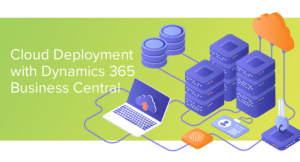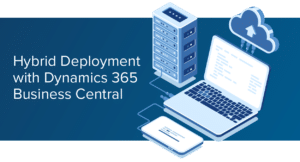When considering deployment options for Dynamics 365 Business Central, it’s essential to evaluate the trade-offs between on-premises and cloud-based solutions. Let’s dig into your options and explore what’s best for your business.
Navigating Deployment: Choosing the Right Path for Microsoft Dynamics 365 Business Central
Microsoft Dynamics 365 Business Central, named the best ERP system of 2024 by Forbes Advisor, is a business ERP system that helps organizations work smarter, adapt faster, and perform better. If you’ve already decided Dynamics 365 is the best option for your organization, you’ve come a long way, but you’ve still got a major decision left to make: how to deploy it.
Deciding how to deploy an ERP solution like Microsoft Dynamics 365 Business Central can be difficult. To give you a little history – Business Central was originally released in April 2018 as a SaaS only solution, however in October 2018, Business Central became the official successor to Microsoft Dynamics NAV as Microsoft released Business Central (on-premises), supporting on-premises, cloud and hybrid deployments. Over the last few years, Microsoft has advocated a cloud-first strategy alongside full continued support for on-premises deployments.
Choosing the best deployment method for your business can be a tough decision, but the good news is Microsoft solutions are built to be highly versatile and there is no one-size-fits-all best way to deploy them. The deployment option you choose will depend on your business, resources and requirements.
On-Premises Deployment for Dynamics 365 Business Central
Who Is This Right For?
 On-premises deployment is suitable for organizations that prefer to host their software and data locally, within their own infrastructure. It’s a good fit for businesses with specific requirements related to data sovereignty, compliance, or existing investments in on-premises infrastructure.
On-premises deployment is suitable for organizations that prefer to host their software and data locally, within their own infrastructure. It’s a good fit for businesses with specific requirements related to data sovereignty, compliance, or existing investments in on-premises infrastructure.
Pros of On-Premises Deployment of Dynamics 365 Business Central
- Control: Organizations have full control over their servers, databases, and network. They can customize and manage the environment according to their specific needs.
- Data Sovereignty: Some industries or regions have strict regulations regarding data storage and privacy. On-premises deployment allows businesses to keep their data within their purview.
- Customization: Businesses can tailor the solution to their unique processes and integrate it with other on-premises systems.
- Offline Access: Users can access Business Central even without an internet connection.
Cons of On-Premises Deployment of Dynamics 365 Business Central
- Infrastructure Costs: Setting up and maintaining servers, databases, and networking infrastructure requires significant investment in hardware, software licenses, and IT expertise.
- Complexity: Managing an on-premises deployment involves time consuming tasks such as backups, security patches, and upgrades. It may require a full IT staff.
- Scalability: Scaling up or down may require additional hardware purchases and adjustments.
- Delayed Updates: Unlike cloud deployments, where updates are automatic, on-premises users need to plan and execute updates manually.
- Less Features: Unlike cloud deployment, there is a list of functionalities that are not supported in an on-premises environment, including some Power Platform functionality and more.
- No Financially Backed SLA: Microsoft online services have financially backed service level agreements, meaning that for cloud-based customers, Microsoft promises a 99.9% uptime. In other words, if the services you’ve subscribed to are not available for less than 99.9% of the time, you may be eligible for financial reimbursement.
Key Considerations for an On-Premises Deployment
If you decide to deploy on-premises, take these considerations into account.
- Hardware Requirements: Ensure that your infrastructure meets the hardware and software prerequisites for Business Central.
- Security: Implement robust security measures, including firewalls, encryption, and access controls.
- Backup and Disaster Recovery: Set up regular backups and disaster recovery plans to safeguard your data.
- Maintenance: Plan for routine maintenance tasks, such as applying patches and updates.
Remember that on-premises deployment provides greater control but requires more effort in terms of management, and it costs more to maintain. Evaluate your organization’s specific needs and constraints before choosing this deployment model.
Cloud Deployment for Dynamics 365 Business Central
 Business Central in the cloud offers flexibility, scalability, and accessibility from anywhere. It provides a unified platform for managing financials, sales, inventory, projects, service, and operations. Users can access Business Central through web browsers or mobile apps, making it ideal for remote work and collaboration.
Business Central in the cloud offers flexibility, scalability, and accessibility from anywhere. It provides a unified platform for managing financials, sales, inventory, projects, service, and operations. Users can access Business Central through web browsers or mobile apps, making it ideal for remote work and collaboration.
Who Is This Right For?
Cloud deployment is suitable for organizations looking for agility, automatic updates, and reduced infrastructure management. It is ideal for businesses that want to scale up or down easily without worrying about hardware limitations and low to no upfront cost for hardware.
Pros Of Cloud Deployment for Microsoft Dynamics 365 Business Central
- Scalability: Easily adjust resources based on business needs.
- Automatic Updates: Seamless, regular updates and new features without manual intervention or downtime.
- Accessibility: Access Business Central from any device with an internet connection.
- No Infrastructure Costs: No need to purchase or maintain on-premises servers. One of the biggest benefits of the cloud is there are no enormous upfront costs. You pay monthly subscription fees as you go. Maintenance, up-to-date software, security and support all fall into the lap of the cloud provider—plus, your staff doesn’t have to waste precious time troubleshooting problems. And most providers include large amounts of storage in their base subscriptions, along with benefits like increased security, file sharing, and all the other perks that come with the cloud. Often, your overall cloud costs are less than the amount of money you would spend for on-premises storage/server use, cooling, floor space, electricity costs, etc.
- Financially backed SLA: 99.9% Guaranteed uptime or you may be eligible for financial compensation.
- Geo-Redundant Solution: No need to worry about data loss with natural disasters. A reliable cloud storage provider offers businesses many features to avoid data loss, including built-in redundancy, failover, backup, automatic logging, monitoring, and more—allowing for shorter recovery time compared with on-premises alternatives.
- Increased Security: While some businesses may be reluctant to transition to the cloud, cloud security has never been better—which takes the burden off your business. According to Gartner estimates, public cloud service workloads will suffer at least 60% fewer security incidents than those in traditional data centers. Unlike on-premises storage, you’ll have a team of global cybersecurity experts helping safeguard your business assets and data. Still, breaches can happen, just like they can with on-premises. Businesses who use the cloud can mitigate this using onboarding and offboarding processes to manage employee access and address how and when their employees use external applications. It’s also to improve your security posture with a zero-trust security model and multi-factor authentication.
- Compliance: Unlike an on-premises solution, Business Central in the cloud has teams of experts who have compliance certifications in dozens of key industries, including health, government, finance, education, manufacturing and media. Not to mention groups that engage globally with governments, regulators, standards bodies and non-governmental organizations.
- Futureproofing: For the past few years, Microsoft’s motto has been “cloud first, mobile first” and that’s unlikely to change anytime soon. By getting on board with Dynamics 365 online, users can utilize the cutting-edge developments being worked on by the Dynamics 365 team. Cloud users will be at the front of the line when it comes to getting more from their CRM and ERP solutions, putting them at a competitive advantage in their markets.
Cons Of Cloud Deployment for Microsoft Dynamics 365 Business Central
- Data Sovereignty: Some organizations may have data residency requirements that cloud deployment might not meet.
- Internet Dependency: Requires a stable internet connection for access.
- Subscription Costs: Cloud deployment involves subscription fees.
Key Considerations for Cloud Deployment:
- Security: Ensure robust security measures, including data encryption and access controls.
- Integration: Plan for integrating Business Central with other cloud or on-premises systems.
- Backup and Recovery: Set up regular backups and disaster recovery plans.
Hybrid Deployment for Dynamics 365 Business Central
A hybrid model combines features from both cloud and on-premises deployment models. It allows organizations to leverage the benefits of both approaches while addressing specific business needs. Here are the key points related to hybrid deployment:
What is Hybrid Deployment with Dynamics 365 Business Central?
 In a hybrid model, Business Central is installed in an external data center managed by a Microsoft partner like Velosio, or a specialized hosting service. It bridges the gap between cloud and on-premises deployments, offering flexibility and control. Though fully integrated with the Microsoft cloud, transactions and data are stored locally on the users’ own data center. This means users gain access to cloud-based services such as machine learning, business intelligence, and development sandboxes, but their data remains separate.
In a hybrid model, Business Central is installed in an external data center managed by a Microsoft partner like Velosio, or a specialized hosting service. It bridges the gap between cloud and on-premises deployments, offering flexibility and control. Though fully integrated with the Microsoft cloud, transactions and data are stored locally on the users’ own data center. This means users gain access to cloud-based services such as machine learning, business intelligence, and development sandboxes, but their data remains separate.
Who Is This Right For?
Organizations may want to consider a hybrid deployment if they want to maintain some data and processes on-premises while utilizing cloud capabilities. Hybrid may also make sense for businesses with specific compliance requirements or existing investments in on-premises infrastructure.
Pros of Hybrid Deployment for Dynamics 365 Business Central
- Flexibility: Choose where to host different components based on your needs.
- Cloud services included: Hybrid deployment isn’t exactly a 50/50 split between online and offline implementation and is run mainly from the cloud. This means hybrid users can enjoy all the benefits and services offered by Dynamics 365 cloud deployment.
- Locally stored data: With a hybrid model, transactions are supported by local application services, and business data is hosted in-house, with the option to sync it to the cloud. For this reason, hybrid deployment is an option for those businesses who need to have fully localized access to business data for compliance purposes, but still want to be able to utilize all that the cloud provides.
- Business Continuity: The ability to use the system offline can be useful to industries in which business continuity is especially important, such as retail or manufacturing. Hybrid deployment allows customers to run their Point-of-Sale operations regardless of connectivity, so that users can capture data and perform transactions whatever their internet status. Any data obtained offline can later be synced to the cloud for business intelligence or reporting purposes.
- Shared data trusteeship: In the hybrid deployment scenario, both Microsoft and the customer are responsible for safeguarding Dynamics 365 data, meaning users can take advantage of the strong security and disaster recovery services offered to cloud users.
Key Considerations for Hybrid Deployment:
- Integration: Plan for seamless integration between on-premises and cloud components.
- Security: Implement robust security measures for both environments.
- Maintenance: Regularly update and manage both on-premises and cloud resources.
Dynamics 365 Business Central Deployment: The Bottom Line
No matter how you choose to deploy Microsoft Dynamics 365 Business Central, you’ll realize ROI, automate and improve processes, and boost productivity. Velosio is here to help you demystify the three different deployment options and determine which one is best for your organization. Learn more about Dynamics 365 Business Central.
 On-premises deployment is suitable for organizations that prefer to host their software and data locally, within their own infrastructure. It’s a good fit for businesses with specific requirements related to data sovereignty, compliance, or existing investments in on-premises infrastructure.
On-premises deployment is suitable for organizations that prefer to host their software and data locally, within their own infrastructure. It’s a good fit for businesses with specific requirements related to data sovereignty, compliance, or existing investments in on-premises infrastructure. Business Central in the cloud offers flexibility, scalability, and accessibility from anywhere. It provides a unified platform for managing financials, sales, inventory, projects, service, and operations. Users can access Business Central through web browsers or mobile apps, making it ideal for remote work and collaboration.
Business Central in the cloud offers flexibility, scalability, and accessibility from anywhere. It provides a unified platform for managing financials, sales, inventory, projects, service, and operations. Users can access Business Central through web browsers or mobile apps, making it ideal for remote work and collaboration. In a hybrid model, Business Central is installed in an external data center managed by a Microsoft partner like Velosio, or a specialized hosting service. It bridges the gap between cloud and on-premises deployments, offering flexibility and control. Though fully integrated with the Microsoft cloud, transactions and data are stored locally on the users’ own data center. This means users gain access to cloud-based services such as machine learning, business intelligence, and development sandboxes, but their data remains separate.
In a hybrid model, Business Central is installed in an external data center managed by a Microsoft partner like Velosio, or a specialized hosting service. It bridges the gap between cloud and on-premises deployments, offering flexibility and control. Though fully integrated with the Microsoft cloud, transactions and data are stored locally on the users’ own data center. This means users gain access to cloud-based services such as machine learning, business intelligence, and development sandboxes, but their data remains separate.